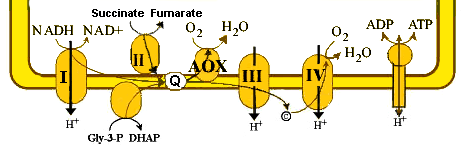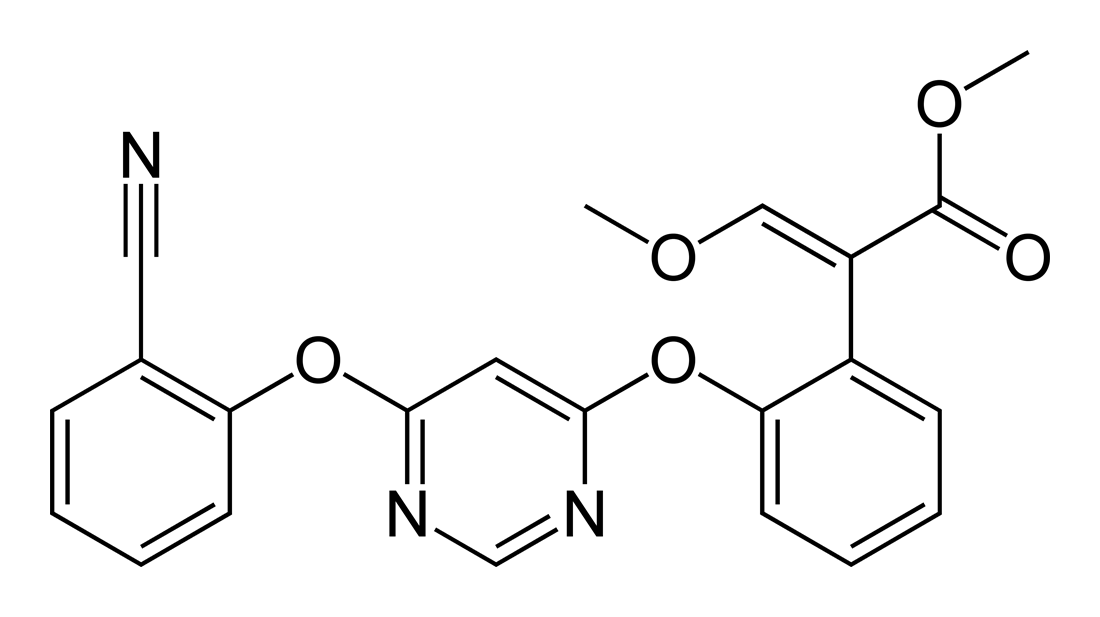Alternative oxidase

Overview
The alternative oxidase is an enzyme that forms part of the electron transport chain in plants, as well as some fungi, protists and possibly some animals.[1][2] Sequences similar to the plant oxidase have also been identified in bacterial genomes.[3][4]
The oxidase provides an alternative route for electrons passing through the electron transport chain to reduce oxygen. However, as several proton-pumping steps are bypassed in this alternative pathway, activation of the oxidase reduces ATP generation. This enzyme was first identified as a distinct oxidase pathway from cytochrome c oxidase as the alternative oxidase is resistant to inhibition by the poison cyanide.[5]
Function
This metabolic pathway leading to the alternative oxidase diverges from the cytochrome-linked electron transport chain at the ubiquinone pool.[6] Alternative pathway respiration only produces proton translocation at Complex 1 (NADH dehydrogenase) and so has a lower ATP yield than the full pathway. The expression of the alternative oxidase gene AOX is influenced by stresses such as cold, reactive oxygen species and infection by pathogens, as well as other factors that reduce electron flow through the cytochrome pathway of respiration.[7][8] Although the benefit conferred by this activity remains uncertain, it may enhance an organisms' ability to resist these stresses, through reducing the level of oxidative stress.[9]

Unusually, the bloodstream form of the protozoan parasite Trypanosoma brucei, which is the cause of sleeping sickness, depends entirely on the alternative oxidase pathway for cellular respiration through its electron transport chain.[10][11] This major metabolic difference between the parasite and its human host has made the T. brucei alternative oxidase an attractive target for drug design.[12][13] Of the known inhibitors of alternative oxidases, the antibiotic ascofuranone inhibits the T. brucei enzyme and cures infection in mice.[14][15]
In fungi, the ability of the alternative oxidase to bypass inhibition of parts of the electron transport chain can contribute to fungicide resistance. This is seen in the strobilurin fungicides that target complex III, such as azoxystrobin, picoxystrobin and fluoxastrobin.[16] However, as the alternative pathway generates less ATP, these fungicides are still effective in preventing spore germination, as this is an energy-intensive process.[17]
Structure and mechanism
The alternative oxidase is a integral membrane protein that is tightly bound to the inner mitochondrial membrane.[18] The enzyme has been predicted to contain a coupled diiron center on the basis of a conserved sequence motif consisting of the proposed iron ligands, four glutamine and two histidine amino acid residues.[19] The electron spin resonance study of Arabidopsis thaliana alternative oxidase AOX1a showed that the enzyme contains a hydroxo-bridged mixed-valent Fe(II)/Fe(III) binuclear iron center.[20] A catalytic cycle has been proposed that involves this di-iron center and at least one transient protein-derived free radical, which is probably formed on an invariant tyrosine residue.[21]
See also
References
- ↑ McDonald A, Vanlerberghe G (2004). "Branched mitochondrial electron transport in the Animalia: presence of alternative oxidase in several animal phyla". IUBMB Life. 56 (6): 333–41. PMID 15370881.
- ↑ Sluse FE, Jarmuszkiewicz W (1998). "Alternative oxidase in the branched mitochondrial respiratory network: an overview on structure, function, regulation, and role". Braz. J. Med. Biol. Res. 31 (6): 733–47. PMID 9698817.
- ↑ McDonald AE, Amirsadeghi S, Vanlerberghe GC (2003). "Prokaryotic orthologues of mitochondrial alternative oxidase and plastid terminal oxidase". Plant Mol. Biol. 53 (6): 865–76. PMID 15082931.
- ↑ Atteia A, van Lis R, van Hellemond JJ, Tielens AG, Martin W, Henze K (2004). "Identification of prokaryotic homologues indicates an endosymbiotic origin for the alternative oxidases of mitochondria (AOX) and chloroplasts (PTOX)". Gene. 330: 143–8. PMID 15087133.
- ↑ Moore AL, Siedow JN (1991). "The regulation and nature of the cyanide-resistant alternative oxidase of plant mitochondria". Biochim. Biophys. Acta. 1059 (2): 121–40. PMID 1883834.
- ↑ Juszczuk IM, Rychter AM (2003). "Alternative oxidase in higher plants" (PDF). Acta Biochim. Pol. 50 (4): 1257–71. PMID 14740012.
- ↑ Vanlerberghe GC, McIntosh L (1997). "Alternative oxidase: From Gene to Function". 48: 703–734. PMID 15012279.
- ↑ Ito Y, Saisho D, Nakazono M, Tsutsumi N, Hirai A (1997). "Transcript levels of tandem-arranged alternative oxidase genes in rice are increased by low temperature". Gene. 203 (2): 121–9. PMID 9426242.
- ↑ Maxwell DP, Wang Y, McIntosh L (1999). "The alternative oxidase lowers mitochondrial reactive oxygen production in plant cells". Proc. Natl. Acad. Sci. U.S.A. 96 (14): 8271–6. PMID 10393984.
- ↑ Chaudhuri M, Ott RD, Hill GC (2006). "Trypanosome alternative oxidase: from molecule to function". Trends Parasitol. 22 (10): 484–91. PMID 16920028.
- ↑ Clarkson AB, Bienen EJ, Pollakis G, Grady RW (1989). "Respiration of bloodstream forms of the parasite Trypanosoma brucei brucei is dependent on a plant-like alternative oxidase" (PDF). J. Biol. Chem. 264 (30): 17770–6. PMID 2808350.
- ↑ Nihei C, Fukai Y, Kita K (2002). "Trypanosome alternative oxidase as a target of chemotherapy". Biochim. Biophys. Acta. 1587 (2–3): 234–9. PMID 12084465.
- ↑ Grady RW, Bienen EJ, Dieck HA, Saric M, Clarkson AB (1993). "N-n-alkyl-3,4-dihydroxybenzamides as inhibitors of the trypanosome alternative oxidase: activity in vitro and in vivo" (PDF). Antimicrob. Agents Chemother. 37 (5): 1082–5. PMID 8517695.
- ↑ Minagawa N, Yabu Y, Kita K, Nagai K, Ohta N, Meguro K, Sakajo S, Yoshimoto A (1997). "An antibiotic, ascofuranone, specifically inhibits respiration and in vitro growth of long slender bloodstream forms of Trypanosoma brucei brucei". Mol. Biochem. Parasitol. 84 (2): 271–80. PMID 9084049.
- ↑ Yabu Y, Yoshida A, Suzuki T, Nihei C, Kawai K, Minagawa N, Hosokawa T, Nagai K, Kita K, Ohta N (2003). "The efficacy of ascofuranone in a consecutive treatment on Trypanosoma brucei brucei in mice". Parasitol. Int. 52 (2): 155–64. PMID 12798927.
- ↑ Miguez M, Reeve C, Wood PM, Hollomon DW (2004). "Alternative oxidase reduces the sensitivity of Mycosphaerella graminicola to QOI fungicides". Pest Manag. Sci. 60 (1): 3–7. PMID 14727735.
- ↑ Avila-Adame C, Köller W (2003). "Impact of alternative respiration and target-site mutations on responses of germinating conidia of Magnaporthe grisea to Qo-inhibiting fungicides". Pest Manag. Sci. 59 (3): 303–9. PMID 12639047.
- ↑ Berthold DA, Stenmark P (2003). "Membrane-bound diiron carboxylate proteins". Annual review of plant biology. 54: 497–517. PMID 14503001.
- ↑ Berthold DA, Andersson ME, Nordlund P (2000). "New insight into the structure and function of the alternative oxidase". Biochim. Biophys. Acta. 1460 (2–3): 241–54. PMID 11106766.
- ↑ Berthold DA, Voevodskaya N, Stenmark P, Gräslund A, Nordlund P (2002). "EPR studies of the mitochondrial alternative oxidase. Evidence for a diiron carboxylate center". J. Biol. Chem. 277 (46): 43608–14. PMID 12215444.
- ↑ Affourtit C, Albury MS, Crichton PG, Moore AL (2002). "Exploring the molecular nature of alternative oxidase regulation and catalysis". FEBS Lett. 510 (3): 121–6. PMID 11801238.
External links
- Electron transport proteins
- InterPro entry on alternative oxidases
- alternative+oxidase at the US National Library of Medicine Medical Subject Headings (MeSH)
- Alternative respiration Root Research Introduction Virtual Course Seminar